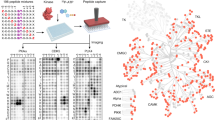Abstract
CYSTATHIONINE formation in Escherichia coli involves the functioning of two enzymes1–3. The first enzyme is present in certain cystathionine-requiring auxotrophs such as E. coli strain 7/9 but absent from others (such as strain 2/2) and catalyses the formation of O-succinyl homoserine from homoserine and succinyl coenzyme A. The nature of the product was originally deduced from the chemical and biological properties of the compound3 and this was confirmed by comparison with chemically synthesized O-succinyl homoserine4. The second enzyme which is absent from strain 7/9 but present in strain 2/2 forms cystathionine from O-succinyl homoserine plus cysteine2. Further evidence for the functioning of O-succinyl homoserine as a methionine precursor in E. coli was afforded by the observation5 that strain 7/9 accumulated O-succinyl homoserine when grown with limiting amounts of homocysteine although the addition of methionine abolished the accumulation. Nutritional and genetic investigations with methionine-requiring strains of Salmonella typhimurium6 suggested that the biosynthetic pathway might be the same as in E. coli. Two other observations support this view. First, organisms of S. typhimurium strain B23, a cystathionine-requiring mutant, accumulate O-succinyl homoserine in the culture fluid5, while a genetically dissimilar cystathionine-requiring strain (strain A15) shows no accumulation. Secondly, extracts from S. typhimurium strain A form cystathionine from O-succinyl homoserine plus cysteine7. These data supported the view that cystathionine and O-succinyl homoserine are methionine precursors in S. typhimurium and, as the accumulation of O-succinyl homoserine by strain B23 (like that with E. coli strain 7/9) was prevented by methionine5, it appeared that control of the biosynthetic pathway might be similar to that in E. coli2. The present work shows that S. typhimurium contains both enzymes of cystathionine formation and that enzymatic repression and feed-back inhibition occur.
This is a preview of subscription content, access via your institution
Access options
Subscribe to this journal
Receive 51 print issues and online access
$199.00 per year
only $3.90 per issue
Buy this article
- Purchase on Springer Link
- Instant access to full article PDF
Prices may be subject to local taxes which are calculated during checkout
Similar content being viewed by others
References
Rowbury, R. J., Biochem. J., 81, 42P (1961).
Rowbury, R. J., Biochem. J., 82, 24P (1962).
Rowbury, R. J., J. Gen. Microbiol., 28, 5 (1962).
Rowbury, R. J., and Woods, D. D., J. Gen. Microbiol. (in the press).
Rowbury, R. J., J. Gen. Microbiol. (in the press).
Smith, D. A., J. Gen. Microbiol., 24, 335 (1961).
Flavin, M., Delavier-Klutchko, C., and Slaughter, C., Science, 143, 50 (1964).
Rowbury, R. J., and Woods, D. D. (in preparation).
Author information
Authors and Affiliations
Rights and permissions
About this article
Cite this article
ROWBURY, R. Synthesis of Cystathionine and its Control in Salmonella typhimurium. Nature 203, 977–978 (1964). https://doi.org/10.1038/203977a0
Published:
Issue Date:
DOI: https://doi.org/10.1038/203977a0
This article is cited by
-
Methionine and vitamin B12 repression and precursor induction in the regulation of homocysteine methylation in Salmonella typhimurium
Molecular and General Genetics MGG (1973)
-
Genetic analysis of suppressors of methionine mutants of Salmonella typhimurium
Heredity (1967)
-
Methionine genes and enzymes of Salmonella typhimurium
Heredity (1966)
-
Physiologische Untersuchungen an Micrococcus denitrificans Beijerinck und auxotrophen Mutanten
Archiv f�r Mikrobiologie (1966)
Comments
By submitting a comment you agree to abide by our Terms and Community Guidelines. If you find something abusive or that does not comply with our terms or guidelines please flag it as inappropriate.



